 |
 |
12.19.25

The Best Leadership Books of 2025
THE titles listed below, published in 2025, improve our self-awareness regarding relationships and communication the sine qua non of leadership and provide us with a wider perspective on innovation and the changes taking place around us.
(W. W. Norton & Company, 2025)
(TarcherPerigee, 2025)
(Harvard Business Review Press, 2025)
(Grand Central Publishing, 2025)
(Harriman House, 2025)
(Crown Currency, 2025)
(Harvard Business Review Press, 2025)
(Wiley, 2025)
(Scribner, 2025)
(Harvard Business Review Press, 2025)
(Wiley, 2025) Biographies:
(W. W. Norton & Company, 2025)
(Harvard Business Review Press, 2025)
(Fast Company Press, 2025)
(Harvard Business Review Press, 2025)
Posted by Michael McKinney at 10:21 AM
12.18.25

Leading Thoughts for December 18, 2025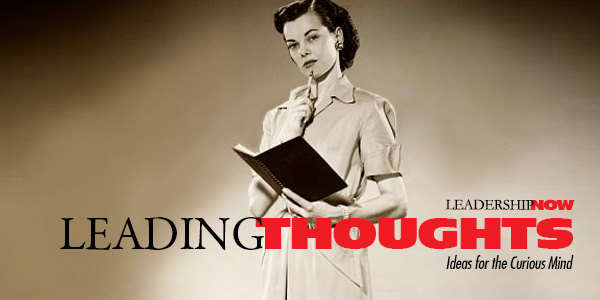
IDEAS shared have the power to expand perspectives, change thinking, and move lives. Here are two ideas for the curious mind to engage with: L David Marquet and Michael Gillespie on focusing on our future self: “By changing our time-based point of reference, we inoculate ourselves from the present moment-biased effect of temporal discounting that we are otherwise subject to. The temporal distance reduces the importance and even the visibility of practical constraints. We do not feel them. When those practical constraints fade away, what we are left with is our ideal self. It is almost always a better human and allows us to focus on what we care most about, distinct from the urgent hassles, compromises, concessions, and justifications of today.” Source: Distancing: How Great Leaders Reframe to Make Better Decisions Margaret Andrews on managing yourself: “Self-understanding gives us insight, but self-management helps us get there. Altering the way we behave changes the way people perceive and respond to us, and can change the way we think and feel about ourselves. With time and practice, the new behavior becomes a more natural component of our leadership style and way of being. This, in turn, has transformative effect on our own leadership abilities as well as the product of the work we do with and through others.” Source: Manage Yourself to Lead Others: Why Great Leadership Begins with Self-Understanding Look for these ideas every Thursday on the Leading Blog. Find more ideas on the LeadingThoughts index.
Posted by Michael McKinney at 03:26 PM
12.15.25

Lessons from the Octopus About Leading AI Transformation
SIXTY-SIX million years ago, an asteroid strike wiped out the dinosaurs and 75% of Earth’s species. Among the survivors was a creature that would teach us critical lessons about thriving amid disruption: the octopus. While other animals’ external armor was useless against this new threat, the octopus survived by being radically adaptable. It has a rare ability; it can edit its RNA to adjust to new conditions within hours. Today’s leaders face their own asteroid strike: artificial intelligence. And like that ancient catastrophe, AI is reshaping the business landscape with breathtaking speed. The question isn’t whether your organization will be transformed, but whether you’ll lead that transformation or be overwhelmed by it. Having worked with dozens of organizations navigating AI adoption, we’ve seen that the most successful leaders don’t treat AI as just another technology implementation. Instead, they recognize it as a catalyst for fundamental organizational redesign. Here are four critical lessons for leading this transformation. 1. Distribute Intelligence to the Front Lines The octopus has two-thirds of its neural tissue in its arms, not its brain. As a result, each arm can solve problems independently while remaining coordinated with the whole. This is the ideal model for organizations: push decision-making power to where the action happens. Most companies still operate with a “hub and spoke” command structure, where information flows up for decisions and then back down for execution. This creates costly delays. AI changes the game by making sophisticated analysis available at every level. A sales rep can now access predictive customer insights. A supply chain manager can run complex optimization scenarios. A customer service agent can resolve issues that once required escalation. Take the case of Mass General Brigham, one of the world’s leading healthcare systems. AI tools help frontline clinicians identify patterns and make treatment decisions faster, while leadership focuses on ensuring these tools integrate seamlessly into workflows and align with core values. Action Step: Identify three decisions currently made at the management level that could be delegated to frontline teams with the right AI support. Then invest in making that support first-rate. 2. Create Knowledge Flow, Not Silos The octopus has a “neural necklace,” a ring of nerve bundles that connects all its arms, enabling instant information sharing without involving the central brain. Your organization needs the digital equivalent. Too many companies treat AI as a series of disconnected point solutions: a chatbot here, a forecasting tool there, an image recognition system somewhere else. But AI’s real power emerges when insights flow freely across organizational boundaries. When your customer service AI informs your product development AI, which feeds your supply chain AI, you create compounding intelligence. This requires rethinking your data architecture. Follow Amazon’s example: for over two decades, teams have been required to make every dataset accessible through well-documented interfaces. Action Step: Map the information flows your AI systems require to be most effective, then eliminate the structural barriers preventing those connections. This often means confronting uncomfortable truths about departmental turf and legacy systems. 3. Embrace Three-Hearted Leadership The octopus has three hearts: one for its body and one for each gill. These hearts serve different purposes, and one can even be stopped temporarily to redirect energy to the others. Modern AI transformation requires a similar multiplicity of leadership approaches and an ability to shift focus. First, you need operational leadership that maintains excellence in your core business while AI tools enhance productivity. Second, you need experimental leadership that explores how AI might create entirely new business models or revenue streams. Third, you need cultural leadership that addresses the very human concerns about what AI means for people’s roles and dignity. The computer accessories company Logitech has balanced all three hearts effectively. It has used AI to streamline operations, explored AI-powered new product categories, and conducted town halls where employees could voice concerns and shape how AI would be deployed. This has resulted in both productivity gains and sustained employee engagement. Action Step: Assess which of these three leadership dimensions you’re neglecting. Then tell managers which styles to focus on and when. 4. Accelerate Through Accurate Sensing The octopus has exceptional sensory capabilities. It has thousands of chemoreceptors on its arms that constantly feed information about its environment. In an AI transformation, your sensing mechanisms are how you detect both opportunities and emerging problems. Most organizations implement AI tools but fail to instrument them adequately. They can tell you if the tool is being used, but not how it’s changing workflows, where it’s introducing errors, or what new capabilities users wish it had. This is flying blind. Build comprehensive sensing into every AI initiative from day one. This means usage analytics, certainly, but also regular qualitative feedback sessions, error tracking with root-cause analysis, and competitive intelligence on how others in your industry are applying similar capabilities. When you spot patterns—positive or negative—you can respond at AI speed rather than committee speed. Action Step: Before deploying your next AI tool, design the feedback mechanisms that will tell you what’s really happening. Make reviewing this feedback a weekly ritual, not a quarterly afterthought. The Transformation Imperative The asteroid that killed the dinosaurs created the conditions for mammals to flourish. AI’s disruption is similarly clearing space for new organizational forms, ones that are more adaptive, more intelligent, and more resilient. The uncomfortable truth is that cautious, incremental approaches won’t cut it. The companies that thrive will be those willing to redesign their organizations around AI’s capabilities—distributing intelligence, connecting insights, embracing complexity, and moving at the speed of algorithms. The question facing every leader today isn’t whether to transform. It’s whether you’ll transform deliberately, learning from nature’s most adaptable creature, or be transformed by forces you didn’t see coming. The asteroid has already struck. The age of the Octopus Organization has begun. 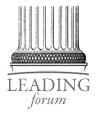 
Posted by Michael McKinney at 11:31 AM
12.11.25

Leading Thoughts for December 11, 2025
IDEAS shared have the power to expand perspectives, change thinking, and move lives. Here are two ideas for the curious mind to engage with: Paul J. H. Schoemaker on the value of scenario planning: “The purpose of developing scenarios is not to pinpoint the future, but rather to experience it. Scenario planning is not really about planning but about changing people’s mindsets to allow faster learning and smarter actions. The process of developing scenarios is one of gaining experience in a simulated future. When You feel the future deep in your bones, you gain a set of instincts that allow you to respond quickly and effectively to new challenges they unfold. The process enlarges the repertoire of responses available to managers based on superior pattern recognition. In an uncertain and changing environment, faster learning is the only lasting source competitive advantage, and scenario planning is a powerful way to accomplish this elusive goal.” Source: Profiting from Uncertainty: Strategies for Succeeding No Matter What the Future Brings Max Bazerman and Michael Watkins on challenging the status quo: “Decision-makers, organizations, and nations often fail to prepare for predictable surprises because of the natural human tendency to maintain the status quo. Above and beyond concerns about the cost and time requirements of change, when a system still functions and there is no crisis to catalyze action, we will keep doing things the way we have always done them. Acting to avoid a predictable surprise requires a decision to act against this bias and to change the status quo. By contrast, most organizations change incrementally, preferring short-term fixes to long-term solutions. To avoid predictable surprises, leaders must make the case for change and eliminate the status quo as an option.” Source: Predictable Surprises: The Disasters You Should Have Seen Coming, and How to Prevent Them Look for these ideas every Thursday on the Leading Blog. Find more ideas on the LeadingThoughts index.
Posted by Michael McKinney at 12:50 PM
12.08.25

Holding the Middle During Organizational Upheaval: The Real Work of Self-Leadership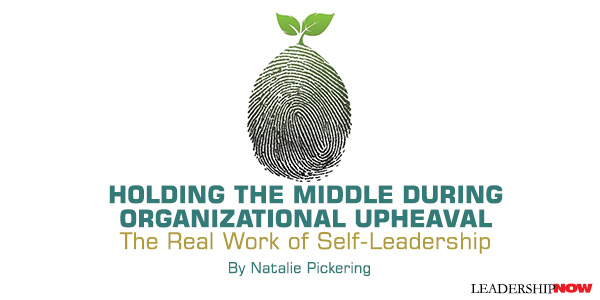
MOST leadership narratives talk about upheaval change as if it’s solely managed as a sequence: a plan, a timeline, a communication strategy, a rollout. Apply the favored change management steps, and all will be well. But when you’re inside a pending reorganization, merger, leadership removal, cultural overhaul, or sudden strategic pivot, you quickly learn something most leadership books never say: The hardest part isn’t the change. It’s the in-between. The stretch of time where what was no longer fits or exists, and what’s coming hasn’t yet taken shape, is an uncomfortable period of ambiguity, disorientation, and suspended identity for organizations, teams, and leaders themselves. Call It Liminality Upheavals such as a reorganization, merger, or unexpected leadership transition create a liminal space — a structural in-between where the old way, strategic plan, norms, and org charts no longer exist but the new one hasn’t been created. What leaders and teams experience inside that space is liminality: the psychological, emotional, and identity-level disorientation that comes from being suspended between two realities. The term liminality comes from the Latin limen, meaning threshold. It originated in the early 1900s when anthropologist Arnold van Gennep used it to describe the middle stage of rites of passage — the ambiguous and amorphous period as someone leaves behind who they were but hasn’t yet stepped into who they’ll become. Later, anthropologist Victor Turner expanded the concept, describing liminality as a space of:
Historically, liminality and the other side of the threshold represented profound transformation. Today, liminality resonates as the psychological and relational experience of navigating major transitions in times when the structures, norms, and identities that once guided us are temporarily gone. It validates the collective unmooring impacting leaders, teams, and the frontline simultaneously. Everyone is in a version of the fog at the same time. Liminality Impact Liminal space can be used for good, but leaders must be honest about how it impacts their own leadership identity as they attend to the same questions for those they’re leading. Numerous organizational impacts during upheaval can contribute to leaders’ liminality-related unmooring. Some of these include:
Statements and questions I’ve heard from leaders I’ve supported in these situations sound like:
Sometimes leaders carry the burden silently, assuming either that they shouldn’t feel unmoored or that honesty about their experience can’t be shared with those they’re leading. In reality, and per the research, ambiguity increases anxiety and emotional contagion. Leaders under high emotional load communicate less effectively, and teams detect a leader’s emotional state with very high accuracy (70-80%). But leaders who acknowledge liminality’s impact on them and the organization isn’t weakness — it’s leadership. Identity Clarity in Liminality When leaders have identity clarity — alignment between who they are, how they lead, and what they stand for — they have a grounded, stable center, while everything around them is shifting and waiting in the middle feels unstable. Research shows that identity-secure leaders better tolerate ambiguity and exhibit resilience and ethical behavior under pressure. Leaders committed to their core, essential foundation, ask themselves during liminal waiting:
Not only does this ground the leader during upheaval-imposed liminality, but it also gives leaders greater capacity to:
Identity clarity doesn’t give leaders all the answers, but it does provide them with a grounded presence that others can anchor to. 3 Strategies to Hold the Middle During Liminality Strategy 1: Name the liminal season clearly and often
Why it works: Research shows that naming an emotion or experience reduces the activation of fear and anxiety. It literally calms the brain. Strategy 2: Use the phrase, “This is hard, and we keep going.”
Acknowledging the discomfort might sound like:
Beyond the emotional validation, the team and frontline also need to know what still matters, what they’re still responsible for, and what they can count on. Strategy 3: Create micro-stability in the middle of macro-uncertainty
Why it works: Predictability is one of the strongest buffers against the stress of uncertainty. Micro-stability equals macro-resilience. Liminality Is Shared and Can Be Utilized Leadership in an era of big change and upheaval isn’t always about having the answers. Of course, decision-making and operations must be managed. But so must identity clarity and grounded presence that’s strong enough to hold the in-between with others. When teams and the frontline are suspended in the middle, they don’t anchor to strategy — they anchor to the human leader in front of them. The leader who can say, “I’m navigating this with you. The unknown is uncomfortable. Let’s stay connected, grounded, and honest as we move forward,” is the leader people trust to guide them through liminality. Acknowledging liminality doesn’t slow organizations down — it stabilizes them. Leaders who convey the truth of the in-between build stronger trust and deeper resilience across their teams. What emerges on the other side is not just a new structure, but a more aligned, adaptive, and human organization.  
Posted by Michael McKinney at 08:57 PM
12.04.25

Leading Thoughts for December 4, 2025
IDEAS shared have the power to expand perspectives, change thinking, and move lives. Here are two ideas for the curious mind to engage with: Jordan Peterson on vision: “Don’t underestimate the power of vision and direction. These are irresistible forces, able to transform what might appear to be unconquerable obstacles into traversable pathways and expanding opportunities. Strengthen the individual. Start with yourself. Take care with yourself. Define who you are. Refine your personality. Choose your destination and articulate your Being. As the great nineteenth-century German philosopher Friedrich Nietzsche so brilliantly noted, “He whose life has a why can bear almost any how.” Source: 12 Rules for Life: An Antidote to Chaos Paul Millerd on prototyping: “Payoff can be profound. For most people, life is not based on all-or-nothing leaps of faith. That’s a lie we tell ourselves so that we can remain comfortable in our current state. We simplify life transitions down to single moments because the real stories are more complex, harder to tell and attract less attention. The headline Quits to Live on a Sailboat seems more impressive and is easier to talk about than Couple Slowly and Purposefully Tests Out a Life Transition While Aggressively Saving Money over Five Years. As a result, we hear fewer of the real stories, most of which include some kind of prototyping. Source: The Pathless Path: Imagining a New Story for Work and Life Look for these ideas every Thursday on the Leading Blog. Find more ideas on the LeadingThoughts index.
Posted by Michael McKinney at 12:06 PM
12.01.25

First Look: Leadership Books for December 2025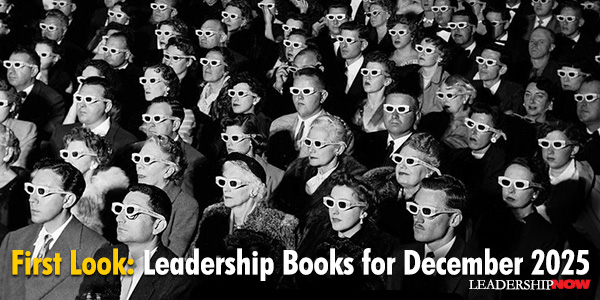
HERE'S A LOOK at some of the best leadership books to be released in December 2025 curated just for you. Be sure to check out the other great titles being offered this month.
In a world more connected than ever, why are we all feeling so disconnected? Leadership expert Dr. Michelle K. Johnston reveals the hidden crisis plaguing modern workplaces: an epidemic of disconnection that’s eroding team performance, personal satisfaction, and organizational success. The Seismic Shift in You offers a transformative approach to leadership that starts with the most critical factor—you. Drawing on years of coaching top leaders and the latest research, Johnston outlines seven powerful shifts to help you lead more effectively, including: Rediscover your sense of purpose and direction, Transform everyday interactions into meaningful connections, Spark authentic engagement by starting from within, and Cultivate high-performing teams grounded in trust and collaboration. With real-world stories and practical tools, Johnston offers the clarity you need to lead with greater meaning, fulfillment, and results.
AI tools are already reshaping the way we work and communicate, but as they gain autonomy, they will no longer be mere tools; they will become active participants in our world. As our digital identities become smarter and more capable, we enter the age of “Identic” AI: a place where ever-present AI companions streamline daily tasks, enhance wellbeing, and offer lifelong learning. For professionals, these intelligent agents will amplify creativity, boost productivity, and expand human potential. But with this extraordinary promise comes profound risks—to individuals, businesses, and society itself. From technology experts Joseph M. Bradley and Don Tapscott, You to the Power of Two is a thought-provoking and timely guide that will prepare readers to thrive in world of personal AI agents
In Monster Transformation, a team of veteran digital leaders delivers an expert framework to digital transformation that focuses on the competencies your employees will need to have―and develop―to enable your organization to function in a world defined by generative artificial intelligence. Monster Transformation blends actionable insights, real-world case studies, and immediately recognizable organizational behaviors that can either move forward or derail transformation in the age of AI. Whether you are leading, a part of, supporting or interested in organizational transformation, this book challenges conventional thought on dealing with transformation, provides insights on how and why barriers to effective change arise and pragmatic mechanisms to address challenges, diminish barriers and leverage employees.
If you're wondering how to stay relevant in a world where AI seems to be mastering capabilities once thought to be uniquely human, from cognitive tasks to emotional intelligence, Human Edge in the AI Age is your answer. This is not another book about what AI can do. It's about what you can do to thrive alongside it. As AI disrupts industries and job roles and the possibility of job displacement looms, it may also herald a new human renaissance---an Era of Entrepreneurs---where individuals take charge of their destinies, innovate fearlessly, and create value grounded in timeless human strengths such as creativity, empathy, and leadership. To navigate this seismic shift, Nitin Seth introduces the POSSIBLE framework, an original eight-dimensional guide to rediscovering the human edge.
Our organizations are stuck. We talk about agility but find ourselves bogged down in bureaucracy. We aspire to innovate but run into systems built to prevent mistakes, not spark breakthroughs. We need to learn and adapt, but we're operating with an outdated playbook built for efficiency and control. And our attempts to fix all this—by pouring trillions into huge, top-down transformations—make the problems worse. But there is a better way: Building an Octopus Organization. One of nature's most intelligent and curious creatures, the octopus is everything your organization needs to be: smart, endlessly adaptable, and highly resilient. Its eight tentacles work in concert, but each can also think for itself. This book shows how to achieve the same balance of cohesion and autonomy and to guide your organization toward a living, breathing system—one that learns, adapts, and thrives by tapping into the distributed intelligence of its people.
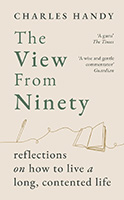   
“You can't think well without writing well, and you can't write well without reading well. And I mean that last "well" in both senses. You have to be good at reading, and read good things.” — Paul Graham, Y Combinator co-founder
Posted by Michael McKinney at 12:59 PM
11.30.25

LeadershipNow 140: November 2025 Compilation
See more on
Posted by Michael McKinney at 02:01 PM
|
BUILD YOUR KNOWLEDGE
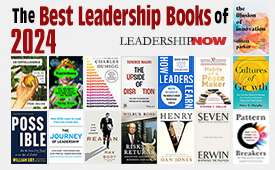 

How to Do Your Start-Up Right STRAIGHT TALK FOR START-UPS 
Grow Your Leadership Skills NEW AND UPCOMING LEADERSHIP BOOKS 
Leadership Minute BITE-SIZE CONCEPTS YOU CAN CHEW ON 
Classic Leadership Books BOOKS TO READ BEFORE YOU LEAD |